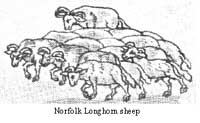|
John Heydon died in 1479, having acquired an interest in two of the manors in Kelling and Salthouse and both advowsons.* He was buried in the Heydon chapel of Norwich Cathedral which he himself had built.
Sir Henry Heydon, his son, was steward to Cecilia, Duchess and widow of Richard Duke of York (and mother of Edward IV). He married Elizabeth (some references call her Ann) daughter of Sir Jeffery Boleyn, a Lord Mayor of London, whose arms are impaled with Heydon on the shields in the nave of Salthouse Church. This Lady Elizabeth, or Ann, was aunt of Ann Boleyn. Sir Henry Heydon was knighted in 1485, and built a noble house and the fine church at West Wickham, Kent, some ten miles from London. But his interest in Norfolk must have been keen for he exchanged his lands in Scarning and Didlington in order to obtain control of the Wychingham manor (sometimes also called Berdwell’s) in Salthouse, in addition to agreeing to pay 30 shillings per annum rent to William Berdwell junior. He was now in possession of the whole of Salthouse parish, though it cannot now be determined where were the boundaries of Brache’s and Wychingham (or Berdwell’s, as it was afterwards called ).
Sir Henry exchanged his lands at Walsingham for the Priory holdings at Melton Magna and Thursford, and built a causeway from Thursford to Walsingham. In the course of six years he erected the magnificent quadrangular Hall at Baconsthorpe, whose walls are still standing behind John Heydon’s solid tower: all damaged, presumably by Cromwellian soldiers. He acquired the last remains in Salthouse of the de Kelling family’s holdings, by exchange, and rebuilt its church. He died in 1503, the same year in which Salthouse Church was completed, and was buried in the Heydon chapel of Norwich Cathedral, which has completely disappeared (together with his tomb).
Henry was followed in 1503 by his eldest son John, aged thirty-three, who was owner of all the Salthouse manors for the forty-seven years until he died in 1550. During his father’s lifetime he was a great courtier and lived on a lavish scale, but after succeeding to the Norfolk estates, appears to have spent most of his time upon them and was created KCB at the coronation of King Henry VIII in 1509. His youngest brother William was killed by the rebels in Kett’s rebellion in 1549, and is buried in St Peter Mancroft, Norwich.
Sir John married Catherine, daughter of Lord Willoughby of Parham, and had several sons and five daughters. He built the Hall at Saxlingham whose ruins are still standing. Sir John and Catherine are both buried in the north aisle
|
|
of Baconsthorpe Church: he died in 1550 at the age of eighty-one, and she in 1542 at the age of seventy-one. They were pre-deceased by their eldest son Sir Christopher who died in 1540. He had married Ann, daughter of Sir John Heveningham of Keteringham, and had four children, one of which, Sir Christopher, succeeded his grandfather in 1550.
During the twenty-nine years Sir Christopher owned his Norfolk estates he was held in great esteem and veneration and was noted for his justice, charity, and remarkable hospitality which was equal to his ample means.
 One memory which has survived through the ages is him entertaining thirty ‘master-shepherds’ of his own flocks, at a Christmas dinner at Baconsthorpe Hall. We do not even know the name of his Salthouse shepherd (or should we call him ‘bailiff’?) nor for certain what breed of sheep grazed the fields of Salthouse. One memory which has survived through the ages is him entertaining thirty ‘master-shepherds’ of his own flocks, at a Christmas dinner at Baconsthorpe Hall. We do not even know the name of his Salthouse shepherd (or should we call him ‘bailiff’?) nor for certain what breed of sheep grazed the fields of Salthouse.
Blomefield’s visitor to Salthouse Church in 1748 refers to the remnants of a stained glass image of this Sir Christopher in the east chancel window, and also to a portrait in the church porch. He must certainly have sometimes come over from Baconsthorpe to worship here.
Sir Christopher died 10 December 1579 and is buried in the south aisle in Baconsthorpe Church with his two wives, Lady Anne and Lady Temperance. The following is a translation of the original Latin:
Here under this tomb lyeth ingraved the bodies of the Ladie Anne Heydon, daughter of Sir William Drury, Knighte, sometime wife of Sir Christopher Heydon of Baconsthorpe in the county of Norfolk, Knt., which Ladie Anne deceased the 7th day of September Ao 1561, and the said Sir Christopher the 10th day of December 1579. And also the Ladie Temperance, second wife of the said Sir Christopher, daughter of Sir Wymunde Carewe, Knt., which Ladie Temperance deceased the 9th day of October in Ao Di 1577.
|
